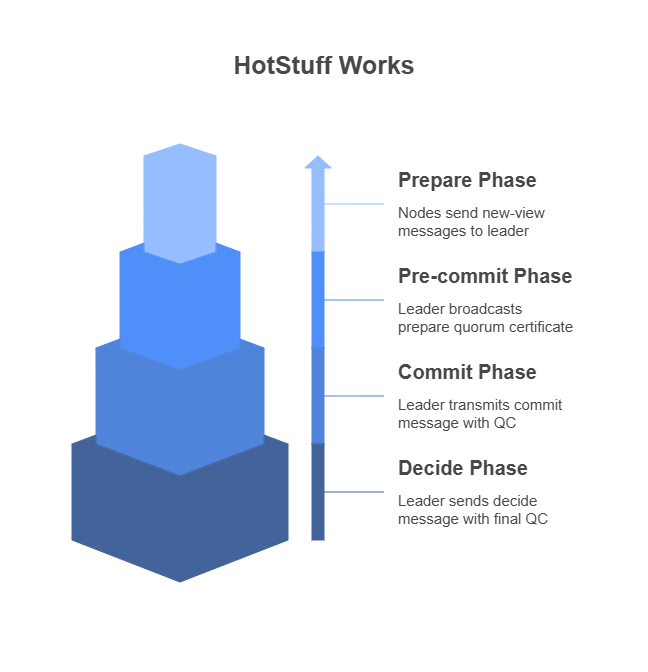Hotstuff Meaning
A Byzantine Fault Tolerant (BFT) consensus technique called HotStuff was created specifically for use in blockchain systems. Reactiveness, or the ability to swiftly adjust to network changes, and linear view changes, which enable quicker and more effective transitions to new protocol phases, are its well-known features. Because of these characteristics, it can be used to create high-performance, extensive blockchain networks.
Here’s a more thorough analysis:
Byzantine Tolerance for Faults:
A certain quantity of malicious or malfunctioning nodes in the network can be tolerated by HotStuff, guaranteeing that the system will continue to function properly even if some nodes exhibit unpredictable behaviour.
Linear View Changes:
HotStuff smoothes the transition between the various consensus protocol phases (referred to as “views”). Transitions are made faster and more effective by using threshold signatures in conjunction with this linear technique to view changes.
Responsiveness:
Due to its quick response to network changes, HotStuff may function well even when the network is unstable.
Pipelining:
Pipelining HotStuff lets it process multiple transactions at once, improving efficiency and throughput.
Reasonability:
Because HotStuff was created with functionality in mind, it can be used in real-world blockchain applications.
Used in LibraBFT:
The LibraBFT is a HotStuff version that is utilized in Facebook’s Libra (now Diem) blockchain.

Hotstuff Meaning
In 2018, VMware Research unveiled the HotStuff class of Byzantine Fault Tolerance (BFT) protocol, which was subsequently showcased at the Symposium on Principles of Distributed Computing (PODC ’19). Guy Golan Gueta, Ittai Abraham, Dahlia Malkhi, Michael K. Reiter, and Maofan Yin co-authored it.
Aiming to outperform conventional BFT protocols, HotStuff is made for the partially synchronous paradigm and offers improved performance and simpler communication.
Key Properties
Key Properties HotStuff addresses three key properties that differentiate it from traditional BFT protocols:
- Communication difficulty during view transitions is greatly decreased by the linear view change characteristic. A properly designated leader only has to send O(n) authenticators (partial or full signatures) to attain consensus after a Global Stabilisation Time (GST) has passed. The communication cost is O(n²) in the worst situation, when there are consecutive leader failures. HotStuff enables immediate view changes without the need for a new sub-protocol, which is a significant improvement over regular PBFT, which requires nodes to wait for 2F+1 messages before a view change can occur.
- Optimistic Responsiveness: This guarantees that any correct leader will only need the first N–F answers to guarantee progress when GST is achieved. This implies that rather than being constrained by the maximum latency, the protocol can move at the rate of the actual network delay.
- Chain Quality: By permitting quick and regular leader rotation, this feature encourages equity and vitality within the system.
You can also read Meaning of MetaMask, Advantages, Functionality & Purpose
Comparison to Traditional PBFT
In contrast to conventional PBFT, comparing HotStuff to PBFT-style methods, the following modifications lead to better performance:
- Communication Topology: HotStuff employs a star topology as opposed to PBFT-style protocols, which use a mesh communication topology in which every message is broadcast to neighbouring nodes. This architecture greatly simplifies communication by having a leader gather all consensus messages before broadcasting them to other nodes.
- View Change Process: The view-change procedure is integrated into HotStuff’s regular mode. In contrast to PBFT, which requires nodes to wait for a threshold of view-change messages, this enables nodes to transition to a new view immediately.
- Communication Footprint: While protocols such as BFT-SMaRt (a PBFT variation) have a quadratic communication footprint (O(n²)), HotStuff maintains a linear communication footprint (O(n)) during leader failover.
System Model
Standard BFT presumptions govern how System Model HotStuff functions:
- The system has N = 3F + 1 nodes, where F is the number of defective nodes.
- Nodes use dependable and authorised communication lines to exchange messages point-to-point.
- It is assumed that the network is somewhat synchronous.
- In order to further reduce communication complexity, it makes use of threshold signatures, in which every node uses a single public key while every replica uses a different private key.
- Hash functions in cryptography provide messages distinct identifiers.
How HotStuff Works (Phases)

HotStuff Works
The Phases of How HotStuff Operates To reach unanimity, HotStuff operates in four stages:
- Prepare Phase: N–F nodes send “new-view” messages to a new leader. The most recent branch with the highest Quorum Certificate (QC) of prepared messages is then determined by processing these messages. A data structure that shows a group of signatures from N–F replicas and certifies that the necessary message threshold has been reached is called a quorum certificate.
- Pre-commit Phase: A leader creates a “prepare quorum certificate” after receiving N–F prepare votes. After that, a PRE-COMMIT message is broadcast with this QC. A replica replies to this communication by casting a pre-commit vote.
- Commit Phase: A “PRE-COMMIT quorum certificate” is produced when the leader obtains N–F pre-commit votes. This is the COMMIT message that is transmitted. After receiving this, replicas lock the PRE-COMMIT quorum certificate and reply with their commit vote to guarantee the algorithm’s security, even in the event that a view change takes place.
- Decide Phase: A COMMIT quorum certificate is created after the leader obtains N–F commit votes. A DECIDE message is sent to other nodes with this final QC. A new view starts when replicas execute the request after receiving the DECIDE message since it contains a certificate or value that has already been committed.
You can also read Benefits Of Bitcoin, Disadvantages And Characteristics
Guarantees of Liveness and Safety
Better modularity, a cleaner design, and autonomous development control are made possible by HotStuff’s explicit separation of its liveness and safety algorithms.
- Liveness (Progress): A component known as Pacemaker is used by HotStuff to guarantee liveness. After GST, Pacemaker promises development within a specified time frame. This is accomplished by the deterministic choice of a distinct and appropriate leader for that “height” and by guaranteeing that replicas remain at that “height” for adequate amounts of time.
- Safety: HotStuff’s voting and pertinent commit rules ensure safety. A key component of the PRE-COMMIT quorum certificate’s safety mechanism is the locking of the certificate during the commit phase.
Applications and Advantages
HotStuff is a straightforward but effective protocol that operates at the network’s actual speed while offering linearity and responsiveness without extra latency. When compared to PBFT-style protocols, its linear communication complexity lowers expenses.
- Applications: LibraBFT, a distributed database created for a global currency suggested by Facebook, uses HotStuff in various forms.
- Framework Capability: It can also express additional protocols, including DLS, PBFT, Casper, and Tendermint. This demonstrates its fundamental importance in the context of BFT consensus.
You can also read HTTP REST API Blockchain: A Comprehensive Beginners Guide
